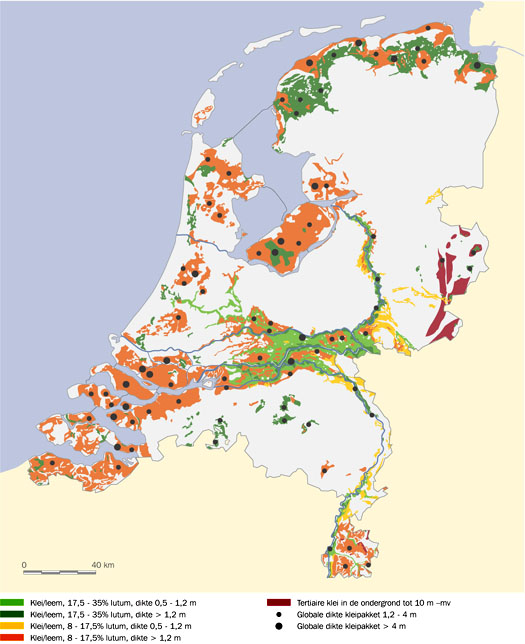Clay is deposited gravel, which consists mainly of clay: little flat plates sitting together. These ground particles are smaller than 2 micrometers and are called lutum.
Soil with more than 25% lutum parts is clay, more than 50% lutum is heavy clay.
Brook clay (named to the place the deposit is found) is the purest type of clay. This clay is removed from the mountains by small streams and rivers, so there is no sand and earth in.
Finding clay
 Sea clay is clay that is deposited by the sea; rivers and creeks deposit river- en creek clay.
Sea clay is clay that is deposited by the sea; rivers and creeks deposit river- en creek clay.
Sea clay is bluish gray, river clay brown. Sea clay contains less organic matter than river clay, but more calcium (shellfish).
Especially low-lying flood plains have gathered heavy clay. This basin clay is very tough and therefore very difficult to work. Fresh layers are sometimes identified by their bare splitting surface. There are maps that indicate areas of clay.
http://www.natuurinformatie.nl/ndb.mcp/natuurdatabase.nl/i000328.html
If the common mineral feldspar eons weathers, it forms the clay. Clay consists of dehydrated silica (SiO2), alumina (Al2O3), water (35%) and metal and other compounds. The clay particles are tiny, with more than one billion in a cubic millimeter. This flat, elongated and very often hexagonal slices stick by intermediate moisture together like glass plates. By kneading those slices are arranged in the same direction. A few days rest between kneading promotes water distribution. The brick -like connection between the particles ensures sturdiness.
Moist clay is wet and squishy like mud. Clay is fired for pottery, ceramic or brick. At a temperature of 900 degrees it becomes hard because the clay particles sinter together.
For pots you don’t use any calcareous clay, because then they are not fireproof.
